|
|
Isonomy

|
|
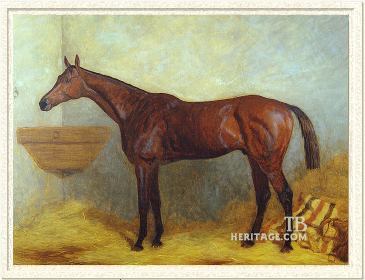 |
|
|
Isonomy was one of the most popular and durable performers of his era, and an influential stallion who produced two English Triple Crown winners and two outstanding sire sons. The Duke of Portland, who owned many great stars of the English turf, once said, "Next to my own horse, St. Simon, I should have preferred to own the great Isonomy rather than any other horse I have ever known."
|
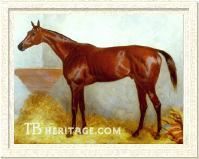
Sterling
| |
Isonomy was sired by Sterling, a horse whose biggest win had come in the Liverpool Autumn Cup. In addition to Isonomy, an early winner for Sterling, he sired Paradox, winner of the Two Thousand Guineas and Grand Prix de Paris, Sussex Stakes, Champion Stakes and runner-up in the Derby; Enterprise, winner of the Two Thousand Guineas; Enthusiast, winner of the Two Thousand Guineas and Sussex Stakes; and Harvester, winner of the Derby Stakes in a dead-heat with St. Gatien. Generally, Sterling sired horses whose best distance was a mile or a litte over, but he did get some good stayers, including Isonomy, and several of his sons were influential in steeplechase breeding, and a grandson, Wavelet's Pride (by Isonomy's brother, Fernandez), led the jumpers sires list in the U.K. for ten years. |
The dam of Isonomy was Isola Bella, a daughter of "The Emperor of Stallions" Stockwell. That magnificent stallion had sired twelve classic winners, six of those winners of the St. Leger. The dam of Isola Bella was Isoline, by Ethelbert. Isoline had first class racing form, as she captured both the Manchester Cup and the Goodwood Cup. As a producer, she foaled two high class performers -- St. Christopher, a star in France, with victories in the Prix du Cadran, Prix Rainbow, and Grand Prix de Paris; and Braconnier, winner in England of the Jockey Club Cup and in France of the Prix Lupin. Isola Bella could not match her immediate family's exploits and was a failure on the racecourse. But a Stockwell filly of good family was always a welcome addition to any breeder's broodmare band, and so Isola Bella was sent to the Graham family's Yardley Stud near Birmingham. There, in 1875, she dropped her foal by Sterling.
Isonomy was a May foal, and consequently was very small. In fact, when full grown, he topped out at only 15.2 hands. John Griffiths, who took care of Isonomy during his stallion career, observed that Isonomy was too short in the neck, but he "had wonderful quarters and a splendid back, and was the deepest horse through the heart I ever saw." And Isonomy had a strong competitive spirit packed into that heart, as well. Trainer John Porter visited Yardley to take a look at the twenty or so yearlings slated to be sold at the Doncaster sales; when they were roused to run about the paddock, he noticed the smallest youngster "threading his way through them in a determined effort to get to the front...taking no bullying from any of them." Porter purchased this youngster for one of his owners--Frederick Gretton, who had leased Sterling during his racing career, for 360 guineas. Looking for a name which began with "iso" in the dictionary, he settled on Isonomy, defined in the dictionary he was scanning as "equality of laws or rights."
Isonomy on the Turf
The turf analyst and writer J.B. Robertson ("Mankato") observed, "All courses and galloping surfaces, hard or soft, came alike to Isonomy." Isonomy's trainer, John Porter, said, "Resolution and grit were very conspicuous traits in his character, and he had a very hardy constitution."
Porter took the little colt to his Kingsclere training yard. As a juvenile, Isonomy started only three times, and finished the season with a win, a place and a third. He was third in his debut, the Brighton Two-Year-Old Stakes, in early August. Sent to Newmarket, Isonomy captured the Second Nursery Stakes late in September. His last race was also at Newmarket, in which he finished second by a head, carrying eleven more pounds than the Broomielaw colt, Beadman.
Isonomy's juvenile form was satisfactory enough to merit consideration for the following season's classic races. But his owner was a gambling man, and he kept his colt out of the classic fray, directing Porter to prepare him for only one race as a three-year-old -- the Cambridgeshire Handicap. Consequently, Isonomy disappeared from public view from the end of October 1877 until October, 1878, when the Cambridgeshire was run. With only three small races as a juvenile under his belt and up against older horses, Isonomy was almost completely overlooked among the 34 contestants and went off at 40-1 odds, under an impost of only 99 pounds. The British racing public was stunned, as this small, unheralded colt scored a decisive two length victory. Finishing fourth was Hampton, a six-year-old and a formidable handicap performer, having captured several important races during his career, including the Goodwood Cup and the Doncaster Cup. Gretton pocketed over £42,000 in prize money and winning bets on his colt that afternoon.
At four, Isonomy was out eight times, and won six races. He was defeated in his debut, the Newmarket Handicap, by the American colt, Parole, who carried the colors of Pierre Lorillard's Rancocas Stable. Sent to Ascot, Isonomy scored impressive victories in the space of two days, in the Ascot Gold Vase and the Ascot Gold Cup. The former race was run at a distance of two miles, and Isonomy won by half a length from the Derby and St. Leger champion of two years previously, Silvio. The Ascot Gold Cup was a half mile longer, and Isonomy defeated the previous year's Derby runner-up, Insulaire, by two lengths.
Less than a month later, Porter had Isonomy at Goodwood for the Goodwood Cup, also at 2-1/2 miles, and Isonomy, with Tom Cannon up, scored by three lengths. In this race, he exacted a measure of revenge over Parole, as the American finished in third place. Next came the two-mile Brighton Cup under an impost of 136 pounds, and another victory. Then came the Great Ebor Handicap at York. Under 134 pounds, Isonomy won by eight lengths. This win sent the little son of Sterling to Doncaster for the Doncaster Cup and the chance to sweep the three major cup races in the same season, a extraordinarily difficult accomplishment. Indeed, the Doncaster Cup proved to be a very grueling race for Isonomy, for it was roughly run and the colt came out of it severely bloodied for his effort.
The most dangerous threat to Isonomy in the Doncaster Cup was Lord Falmouth's filly, Jannette, by Lord Clifden, who had captured the Jockey Club Cup that season, and the year previous, the classic St. Leger. She was ridden by Fred Archer, while Isonomy was partnered, as usual, by Tom Cannon. In the home straight, Jannette was running in front, and Cannon aimed his mount to come alongside her along the rail. In what appeared to be a deliberate foul, Archer maneuvered his foot in such a way as to drive his spur right into the shoulder of the onrushing Isonomy. The colt charged through the hole courageously, tearing his shoulder on Archer's spur, and won the race in a desperate finish. Afterward, Archer proclaimed that his ankles were weak and difficult to control. It was a lame excuse, but Isonomy was swathed in glory for his tremendous heart. The Duke of Portland recollected, "...if Isonomy had not been one of the gamest and best horses that ever ran...he could not possibly have won." It would be exactly seventy years before another horse won the Goodwood Cup, Ascot Gold Cup, and Doncaster Cup in the same season, and that was when the Earl of Derby's superb stayer, Alycidon accomplished the feat in 1949.
The climax of Isonomy's four-year-old season was an anticlimax, as in the Cesarewitch Stakes, Isonomy was pulled to let his stablemate Westbourne win. However Westbourne finished second to Chippendale, while Isonomy ran out of the money. The only consolation in the running of this event for the connections of Isonomy was the fact that he finished ahead of Parole in the race.
Isonomy had only two outings as a five-year-old; the Manchester Cup, which he won by a neck under 138 pounds, and the Ascot Gold Cup. Isonomy won this race for the second year in a row by a length from Chippendale. All told, Isonomy won ten of fourteen starts, with two seconds, a third, and the unplaced finish in which he was held back.
Isonomy in the Stud
Isonomy was sent to stand stud near the little town of Tamworth at Bonehill Paddocks. In two seasons there, Isonomy got only fifteen foals, one of which died young. Not unnaturally, this raised questions about his siring prowess.
One mare Isonomy was mated to in his first season was Remorse. She was a beautifully bred mare, by Hermit out of Vex, a full sister to Galopin. The result of this union was the colt ISOBAR, who was the best representative of Isonomy's first crop. Isobar captured the Rous Memorial Stakes and placed second to Melton in the St. Leger. Another foal Remorse produced, at the age of 24, was McGee, by White Knight. Exported to America, McGee became a very tough stakes winner, and was leading American sire in 1922. The best representatives of McGee included Exterminator, Donerail, In Memoriam, and Viva America. Another member of Isonomy's first crop, CINTRA, captured the Epsom Autumn Handicap.
Isonomy did not long remain at Bonehill Paddocks, as late in 1882, his owner passed away. Gretton's horses were sold at auction in January, 1883, at Tattersalls, Knightsbridge, Isonomy included. Trainer Alec Taylor was sent from Manton Stud to bid on Isonomy for W.S. Crawfurd, representing his wife, the colorful and outspoken Duchess of Montrose. Taylor bid up to 8800 guineas, 800 more than he felt Isonomy was worth, and was topped by Count Szapary, bidding for the French government. Taylor refused to raise the bid, but Edmund Tattersall, a friend of the Duchess, put in a bid of 9000 guineas to get the horse for her, and subsequently wrote the Duchess to tell her of his action. The Duchess gratefully replied, "You are always right." Crawfurd died at Cannes not long afterward, and the Duchess's new Sefton Stud, under development on the site of a former dairy farm at Newmarket, was incomplete, so Isonomy returned to Bonehill Paddocks for one more season, resulting in a crop of nineteen foals.
Isonomy arrived at Sefton in 1884. John Griffiths, one time stud groom to Hermit and Galopin at Blankney Stud, was hired by the Duchess to manage Sefton Stud. It was he who surmised Isonomy's poor foal getting might be due to excess weight, and worked diligently to get the stallion in proper trim. Once Isonomy's weight was reduced, he became a very successful foal getter.
At Sefton, Isonomy enjoyed better quality books of mares, and the results made him one of the most popular stallions of his era. While never leading sire in England, he was second three times. Isonomy was the sire of two Triple Crown champions--COMMON and ISINGLASS--a feat not matched until Bayardo sired Gay Crusader and Gainsborough. However, the Triple Crown victories of Gay Crusader and Gainsborough were achieved in wartime substitute races at Newmarket during World War I. The terminally ill Crawfurd had expressed the thought that Isonomy might cross well on daughters of Hermit, and this proved to be so: eight of Isonomy's eighteen most notable stakes winners were out of Hermit mares, and his daughters with Hermit as broodmare sire, were very successful. |

Gallinule

Common
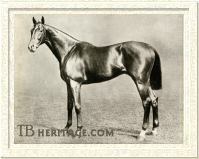
Isinglass

Ravensbury
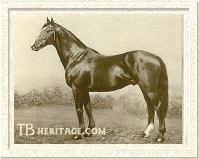
Fortunio
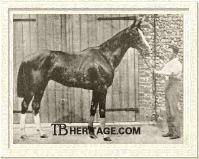
Satiety
| |
GALLINULE (1884), out of Moorhen, by Hermit, was not a successful racehorse, but he was one of Isonomy's two best sire sons, although it was through ISINGLASS that the sire line descended. A handsome chestnut with a blaze and three white socks, Gallinule showed class only as a juvenile. He placed once as a three-year-old, but the rest of his career was a study in futility, for he never placed among the top three again, though he raced through the age of five. Sometime during his racing career, Gallinule was discovered to be a bleeder, but how much that compromised his running has been open to conjecture.
From Captain Henry Greer's Brownstown Stud in Ireland he became a popular stallion, extremely successful in Ireland, and headed the British sires list in 1904, due largely to the triumphs of his brilliant daughter, Pretty Polly, victress in 22 of her 24 races, including the One Thousand Guineas, Oaks, St. Leger, and twice the Coronation Cup. He was a highly successful broodmare sire, leading that list five times, due to classic winners The Panther, Electra, and Spion Kop, and such fine performers as Foxlaw, Prince Chimay, Siberia, and Cellini. He also had an important influence on jumper breeding.
COMMON (1888), from the mare Thistle, by Scottish Chief, won the English Triple Crown and the St. James's Palace Stakes at age three, his only season. Bred by Lord Alington and raced by his breeder in partnership with Sir Frederick Johnstone, he was sold at the phenomenally high price of 15,000 guineas to Sir Blundell Maple, and entered the stud at Childwick Bury at a fee of 200 guineas. He was not a success in the stud, although he did get a classic winner in the 1,000 Guineas winner Nun Nicer, and a son, the good stayer Mushroom (in-bred to Sterling), became a successful sire in Belgium. His fee dropped to 19 guineas towards the end of his stud career, and he died at the age of 24 at Chelmsford Stud.
ISINGLASS (1890), out of the Wenlock mare Dead Lock, was Isonomy's second Triple Crown winner. His dam had previously produced a stakes-winning full brother to Isinglass named ISLINGTON, and a stakes-winning half-brother by Trappist named Gervas, but neither of these were of the same class as ISINGLASS.
In the stud ISINGLASS came up with three classic winners--Cherry Lass, Glass Doll, and Louvois. He also sired Star Shoot, an eight-time leading American sire in the United States, John o' Gaunt, who kept the male line of Isonomy prominent for many more years through his son Swynford and grandson Blandford, sire of four winners of the Derby Stakes. ISINGLASS led the British sire list in 1905, and the broodmare sire list posthumously in 1912; his daughters included Glasalt, an important foundation mare for the Earl of Derby; Goody Two Shoes, dam of Charles O'Malley and third dam of foundation mare Rough Shod II; Lady Lightfoot, the dam of Prince Palatine; and Malatesta, dam of major French winner and sire La Farina.
RAVENSBURY (1890), was out of Penitent, a full sister to the dual-classic winning Hermit filly Shotover -- he would have been a Triple Crown champion in any other year, but had the ill fortune to have been foaled in the same year as ISINGLASS. Ravensbury faced the starter twenty-seven times and won seven races, including the Hardwicke Stakes, the Ascot Stakes, and the Alexandra Plate. He was also a strong second in the Grand Prix de Paris. But eight of his defeats came against ISINGLASS, including second place finishes to that foe in all three of the classic races. At stud, Ravensbury was not successful, his best runner being a colt named Feather Bed, winner of the Chester Cup and Great Yorkshire Handicap.
Isonomy's son JANISSARY was a result of his union with old racetrack rival Jannette. On the racecourse he captured the St. James's Palace Stakes. At stud, when mated to the aged classic-producing mare Pilgrimage, Janissary came up with Jeddah, winner of the 1898 Epsom Derby at 100-1 odds.
|
Other winning sons included PRISONER, out of Lonely, by Hermit, who was a winner of the Doncaster Cup; BLAVATSKY who won the Imperial Produce Stakes; SATIETY (1885), out of Wifey, by Cremorne, won the Windsor Castle Stakes and later sired the winning Satirical (1891) who became the dam of Goodwood Cup winner Rabelais (by St. Simon), a leading sire in France multiple times and the principal link to the St. Simon line in the present; and CONTRACT, out of Wedding Ring, by Hampton, captured the Prince of Wales's Stakes and was later the sire of Conbe, a winner of the Maryland Hunt Cup in the United States.
Isonomy came up with some offspring which won important races on the continent. His son RULER, out of Reate, by Vespasian, was exported to Russia, where he won the Moscow Derby and the Gosudaryni Imperatricy, run over 2400 meters. GALAOR, out of the French mare Fideline, by Dollar, was a top performer in France, annexing the classic Prix Royal Oak, Prix Jean Prat, and the Grand Prix de Deauville. The French-bred FORTUNIO, out of Formalite, by Hermit, ran and won in France and Belgium, primarily over fences, and at age 8 was purchased and brought back to Ireland, where he sired a number of good winners, including the brilliant Delaunay, who won 17 races and then was shipped to France for stud duty. ST. OSYTHE, out of the Hermit mare St. Helena, was a winner in Poland, while FAITHFUL represented Isonomy as a winner in Austria.
|
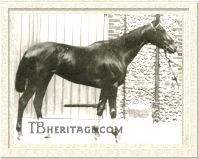
Seabreeze
| |
SEABREEZE, foaled in 1885, was actually the first classic champion to represent her sire, and she was one of several foals Isonomy sired from her dam, the Hermit mare St. Marguerite. St. Marguerite was an extraordinary producer, as in addition to Seabreeze, she produced several other daughters by Isonomy which became fine producers in their own right. A mating to St. Simon resulted in the filly Roquebrune, destined to become the dam of English Triple Crown champion and major sire Rock Sand. But Seabreeze was her finest representative. Bred by the Duchess of Montrose, Seabreeze was raced by Lord Calthorpe and conditioned by her sire's trainer, James Jewitt, at Newmarket. A lovely chestnut filly, she was a good juvenile, but like her sire, improved with age. |
At two, she captured the Biennial Stakes at Ascot and ran second to the Hermit colt Friar's Balsam in both the New Stakes at Ascot and the July Stakes at Newmarket. At three, Seabreeze proved herself the best filly of her generation. After running second to Briar-root in the One Thousand Guineas, she captured the Oaks at Epsom and the St. Leger, with Two Thousand Guineas and Derby champion Ayrshire unplaced. Seabreeze also won the Coronation Stakes and the Lancashire Plate, in the latter race Ayrshire finishing second and Friar's Balsam unplaced. As a broodmare, her best representative was the Donovan colt Tom Cringle, winner of the Ascot Stakes.
Isonomy enjoyed further success when mated to St. Marguerite. She foaled a full brother to Seabreeze named LE VAR in 1892. A dark bay colt, he was unraced at two. He made his racecourse debut in the Derby Stakes, and finished unplaced to Sir Visto. In his next outing, Le Var convincingly defeated Sir Visto for the valuable Princess of Wales's Stakes at Ascot. Sadly, this colt never got a fair chance to prove how good he might have been, for he broke down in the Eclipse Stakes won by Le Justicier. He retired to an unremarkable career at stud.
ANTIBES (1886) provided the union of Isonomy and St. Marguerite with another stakes winner. She took the Yorkshire Oaks, the Midsummer Plate at Newmarket, Doncaster's Zegland Stakes (in a walkover), and the Knowsley Dinner Stakes, and ran second in Newmarket's Champion Stakes. She produced some minor winners that became good producing broodmares. Another sister, HYERES (1889), was exported to Germany as a broodmare. There, she foaled two German classic winners--Hut-ab (by Hugarian sire Talpra Magyar (Buccaneer-Kincsem)), winner of the Preis der Diana, and Hagen, winner of the Deutsches Derby and Preis des Winterfavoriten.
RIVIERA (1887) was a top class two-year-old, winning ten races, including the Windsor Castle Stakes, Ham Stakes, Rous Memorial Stakes (at both Goodwood and Newmarket), and the Champagne Stakes. Tragically, she died as a three-year-old in 1890.
St. Marguerite also produced a filly by Isonomy's son JANISSARY. Named ST. MARINA, she became the third dam of the American broodmare Marguerite, dam of major American handicap star Petee-Wrack, as well as American Triple Crown champion Gallant Fox and his stakes winning full brothers, Foxbrough and Fighting Fox. |
Isonomy as a Broodmare Sire
Isonomy enjoyed considerable success as a sire of broodmares. Of the 23 most important producing daughters of Isonomy, nine were out of Hermit mares. And this affinity continued through succeeding generations, as Isonomy's son ISINGLASS sired Star Shoot from a Hermit mare; Common sired Osbech from a Hermit mare; Isonomy's son Janissary sired Lock and Key (dam of Oaks heroine Keystone II), from Hermit's daughter Seclusion. Even Swynford, still further down the generational path, was the result of crossing Isonomy's grandson John o' Gaunt with Canterbury Pilgrim, a daughter of Hermit's son Tristan.
Undoubtedly, the most significant daughter of Isonomy was ARCADIA. Produced from the Hermit mare Distant Shore, Arcadia became the dam of Cyllene, a compact son of the Bend Or stallion Bona Vista who became an astoundingly successful sire in both Great Britain and Argentina. She was bred by Charles Day Rose. As a juvenile, she showed some talent, winning a small plate and the Royal Plate at Windsor. She completely lost her form at three and was unplaced in both the One Thousand Guineas and the Coronation Stakes. For Rose she later produced the good winner Cyllene, who later sired four winners of the Epsom Derby--Cicero, Minoru, Lemberg, and Tagalie. Cyllene led the British sire list in 1909 and 1910, and after his exportation to Argentina, he headed the sire list there in 1913. He left a son in England who more than filled the void left by his sire's departure --Polymelus, champion British sire five times, sire of five classic champions as well as sire of Phalaris, who went on to become one of the most influential stallions of the twentieth century.
Isonomy's daughter ISOLETTA never ran, but as a broodmare produced five winners. Out of the Muncaster mare Lady Muncaster, Isoletta had much to recommend her as a broodmare prospect, as she came from a powerful female family--that of Queen Mary. Isoletta was acquired by Alfred Cox and for him bred Chere Reine, a Florizel II filly which placed third in the Coronation Stakes, and Galicia, by Galopin. Galicia's racing career was hampered by injury, but as a broodmare for Mr. Cox produced classic winners Lemberg and Bayardo, classics-placed Kwang-su, and classic producer Silesia.
ALIMONY, out of Alibech, by Hermit, became the dam of the fine Irish-bred performer Winkfield's Pride. During his racing career, Winkfield's Pride took the Railway Stakes, the Cambridgeshire Stakes, the Doncaster Cup, and the Prix du Conseil Municipal. Winkfield's Pride spent his stud career in France, where he enjoyed considerable success. Two full sisters, Winkfield's Pearl and Field Money, were tail-female ancestresses of stakes winners.
MARY SEATON was a result of Isonomy's mating with Oaks and St. Leger heroine Marie Stuart, by The Scottish Chief. Undistinguished on the racecourse, she made an admirable broodmare, for she produced two winners--Marajax, an Ajax colt which won the Manchester Cup, and Merry Gal (by Galopin), winner of the Doncaster Cup, the Hardwicke Stakes, Nassau Stakes, and the Princess of Wales's Stakes. Bred to Isonomy's son, Gallinule, Merry Gal produced the top class juvenile White Eagle (in-bred 2 x 3 to Isonomy), later a good broodmare sire in Ireland.
DANCING WATER, out of Pretty Dance, by Doncaster, and SANDFLY, out of Sandiway, by Doncaster, were two daughters of Isonomy imported by American horseman James R. Keene to join the broodmare band at his Castleton Stud near Lexington, Kentucky. Dancing Water was mated to Domino and produced the filly Running Stream. Sent to England to race, Running Stream was victorious in the July Cup. Brought back to the United States to join the Castleton broodmares, Running Stream produced champion colt Pebbles, stakes winners Runnymede and Cataract, as well as the unraced Commando colt Ultimus, destined to become a major American sire.
SANDFLY was imported in foal to Trenton, and in the spring of 1902 dropped a filly later named Midge. This filly subsequently became the dam of Luke McLuke, winner of the Belmont Stakes and a successful American sire. Bred to Keene's stallion Commando, the best son of Domino, Sandfly produced the winning colt Punky and the unraced filly Mosquito. Mosquito, in turn, produced a daughter of Voter named Gnat, who became the dam of Sting (by Spur), a top class handicap performer of the 1920s.
Some other good producing daughters of Isonomy include: MON DROIT (out of In Bounds, by Hermit), dam of Dieudonne, winner of the Middle Park Stakes, Imperial Produce Stakes, and Champion Stakes and later a good sire; ISABELLE (out of Isabel, by Rataplan), dam of Great Yorkshire Stakes winner History; PHANTASIE (out of Palmiet, by The Palmer), dam of Gyp, winner of the Great Ebor Handicap; HEARTSEASE was the dam of Royal Hunt Cup winner Refractor; THEMIS, out of Nellie, by Hermit, was the dam of Frimousse, Pie Powder, and Goose Quill; HECUBA (out of Helen of Troy, by Hermit), dam of Dewhurst Stakes winner Picton; INCOME (full sister to Mon Droit), dam of Craven Stakes winner Port Blair, and of Revenue, third to Doricles in the 1901 edition of the St. Leger; and ISMAY (out of Sainte Alvere, by Hermit), dam of Simon Dale, winner of the Prince of Wales's Stakes and his full brother, Darley Dale (both by St. Simon), winner of the Eclipse Stakes and the King Edward VII Stakes. Darley Dale spent parts of his stud career in both France and Russia, and was the leading sire in Russia in 1913. He was returned to England in 1914 and died in 1919.
There were some daughters of Isonomy which produced notable runners in Europe and South America. In France, the following daughters of Isonomy produced some important winners of races, many of which are now classified as Group I. FIFINE was the dam of Fifre II, winner of the Prix Jean Prat and Prix Lagrange; FANNY, out of Frivola, by George Frederick, became the dam of Farnus, winner of the Prix Morny and the Prix de la Rochette; GAVOTTE, out of Polonaise, by Adventurer, became the dam of Le Guinde, winner of the Prix Noailles; THETIS, out of Serpolette, by Laneret, became the dam of Torquato Tasso, winner of the Prix Royal Oak, and REJOICE, out of Sad, by Hermit, became the dam of Ris Orangis, winner of the Prix du Cadran, regarded as the French equivalent of the Ascot Gold Cup. Then there was SHRINE, a daughter of Pilgrimage. Sent to France in 1894, Shrine became the dam of a colt by The Bard named Saxon who became a winner of the classic Prix du Jockey Club.
RED HOT was a mare whose offspring won important events in Austria-Hungary. Red Hot was out of Red Flag, by Triple Crown winner Lord Lyon and out of Rouge Rose, this making Red Flag a half-sister to Bend Or. Red Hot was mated to Galopin and produced two brothers, Gaga and Ganache. The former captured the Oesterreichisches (Austrian) Derby, and the latter won the Hungarian St. Leger over 2800 meters, the Austriapreis, and the Ketevesek Nagydija over 1400 meters.
OENONE, out of Alone, by Hermit, was the dam of the Irish Lad colt Arashan, winner of several important races in Warsaw; and the German performer Ausmark, winner of the Grosser Preis von Nordrhein Westfalen, was produced from Isonomy's daughter SANTA MARIA.
Isonomy's daughter JANE HADING, a full sister to Janissary, was exported to Argentina. One of her offspring was a colt named Talma, by Hermit's son, Gay Hermit. This colt was a reverse of the Isonomy cross with Hermit on the dam's side. In 1896, Talma captured the Polla de Potrillos in Argentina. Three years later, after his exportation to South Africa, he emerged as the winner of the Durban July Handicap. A full brother to Talma, Valero, captured the Gran Premio Jockey Club and the Gran Premio Nacionale (Argentine Derby), as well as the Clasico Comparacion and the Clasico Capital.
Another daughter of Isonomy who made an impact on Argentinean breeding was SEA AIR. Out of Re-Echo, by Reverberation, Sea Air produced Jockey Club Stakes winner Pietermaritzburg to the cover of St. Simon. Pietermaritzburg was exported to Argentina's Ojo de Agua for stud duty and enjoyed a fruitful career there, leading the Argentine sire list in 1911 and being second in 1912.
Despite this exemplary siring record, Isonomy never once led the list of leading British sires. The honor of leading sire in Britain in the 1880s largely fell to Hermit, who reigned from 1880 through 1886, with Hampton and Galopin assuming leadership at the close of the decade. Isonomy, despite siring two Triple Crown champions in the 1890s, remained in the shadow of the mighty St. Simon, leading British sire from 1890 through 1896. The leading broodmare sire was not recorded until 1899, eight years after Isonomy's death.
Isonomy died on April 7, 1891 from an enlarged heart. The Duchess of Montrose had her prized stallion interred at Sefton, land which is now Stanley House, Newmarket. She presented Isonomy's head, mounted, to farm manager John Griffiths, who gracefully accepted the macabre gift. Years later Griffiths confessed to Edward Morehouse, editor of The Bloodstock Breeders Review, "I could not refuse the gift, but when the Duchess died I gave it to George and Young Graham, the breeders of Isonomy, for I did not care about having a stuffed pet in my house."
After his death Isonomy received a lasting tribute from an unexpected source. He found his way into Victorian popular culture through the courtesy of Sir Arthur Conan Doyle and his fictional detective, Sherlock Holmes. In the short story entitled The Adventure of Silver Blaze, written in 1891 and published in The Strand Magazine in the summer of 1892, Sherlock Holmes tells his companion, Dr. Watson, the illustrious history of Silver Blaze:
"Silver Blaze,' said he, 'is from Isonomy stock, and holds as brilliant a record as his famous ancestor."
--Liz Martiniak
|
|
|
|

